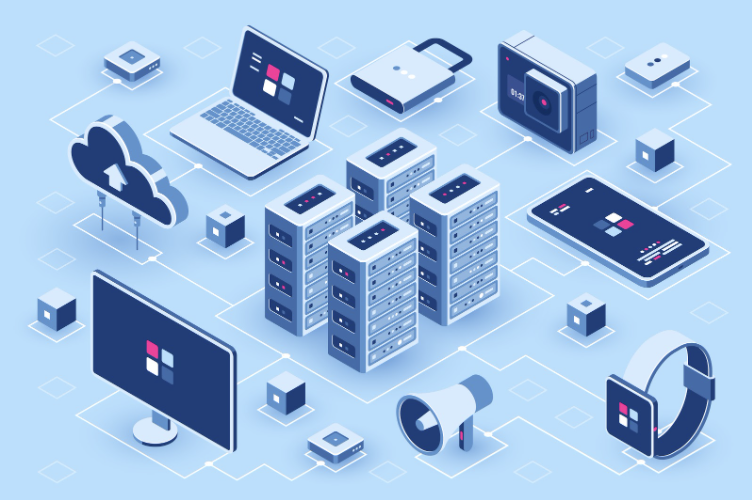Debunking 6 Popular Myths About Edge Computing
Published on 23 Mar 2021
 by Debbie Hoffman
by Debbie Hoffman
‘Edge computing’ is a buzzword that has gained popularity over the years. The problem is the term is applied quite broadly, and people use ‘edge computing’ to discuss a variety of topics. Sometimes, it’s spoken of in conjunction with the cloud; other times, with the Internet of Things or fog computing.
In 2018, Gartner suggested that less than 10% of enterprise-generated data was created using edge computing. However, this number is expected to reach 75% by 2025.
This means businesses will soon put more emphasis on edge computing to process data as close to the source generating it as possible. With the increased importance of edge computing, it’s crucial we address a few misconceptions surrounding it.
We’ll start with six, but first…
What is Edge Computing?
The definition of edge computing is that it’s a “distributed, open IT architecture that features decentralized processing power, enabling mobile computing and IoT technologies”.
It’s an architecture that seeks to address the challenges brought by an abundance of devices operating on a digital network. The concept of it stems from content delivery platforms that host data on servers close to the end-user.
Edge computing is like a technical expansion of content delivery networks, thanks to the modern capabilities of tech. It’s used to address network issues related to latency, bandwidth usage, and congestion.
By moving your data center to the edge of the network, you enable users to store data and carry out computing from their nearest location. This could be beneficial in a voice over IP telephone system, as users would require less bandwidth to enjoy smooth calls.
 Edge computing brings data to the user - Designed by fullvector / Freepik
Edge computing brings data to the user - Designed by fullvector / Freepik
Why is Edge Computing So Important?
There are so many devices operating on the available computer and mobile networks. As a result, there’s a vast quantity of data that needs to be stored, processed, secured, and so on.
You can achieve this with a centralized system, but this can be slow and lead to network bottlenecks. New technology offers speed and convenience, and that’s what edge computing adds to information management.
For example, consider automated mobile apps for business. A business uses apps and software to improve operations and increase productivity. Many apps are constantly collecting data from or sending data to a server.
An app may have actions it needs to take once the data arrives and is processed. The app needs to collect this, process it, and then act. The further away the server is, the longer it takes.
If these apps deploy mobile edge computing (MEC) systems near network access points, they can reduce latency. Reducing latency shortens the time required for data to pass between the server and the access point.
Edge computing makes software and applications use network resources more efficiently and over shorter distances. This improves reliability, data security, and the scale of service.
Everyday examples of edge computing include:
- Self-driving vehicles
- Content delivery services such as content streaming services
- Hospital patient monitoring
- Online gaming
- Telephone and Telecom Industry
Here are six popular myths about edge computing debunked below:
1. Edge Computing Means the End of the Cloud
Edge computing will not replace cloud computing and the reason why is simple: they aim to achieve different goals. Cloud computing focuses on the centralization of data that is not bound by time. This is ideal for processing big data and managing applications on the cloud.
Edge computing, on the other hand, focuses on decentralization with the intention of processing data that’s time-sensitive.
Rather than one replacing the other, edge and cloud are likely to complement each other. The cloud is typically used to power through raw data, while edge computing can be employed to quickly send data to a cloud system. This is ideal for any software that requires real-time information.
2. The Major Benefit is Real-Time Decision-Making
Yes, your real-time decision-making will benefit from the use of edge computing. However, this is not the only upside. Machine learning and artificial intelligence applications also benefit, as can network and application security.
It’s believed that online payments likely reached US$726 billion in 2020. As such, businesses have had to put extra emphasis on data security, check-out security, and so on.
Businesses trading online must already ensure PCI compliance, and customers also expect them to deliver safe browsing and shopping on their sites or platforms. Edge computing can be beneficial here.
Edge computing enables you to do computing, data storage, payment processing, etc.. as close to the user as possible. This means personal data has less distance to travel over any given network. Edge also improves security in the sense that it allows local encryption. This is valuable as users expect a business to protect data.
 Edge computing improves security - Designed by Slidesgo / Freepik
Edge computing improves security - Designed by Slidesgo / Freepik
3. Edge Computing and IoT are the Same Technology
Internet of things (IoT) and edge computing are not the same technologies. However, edge computing offers solutions to challenges created when using IoT devices. These are hardware devices that can transmit data over the internet and are programmed for applications. A network can bottleneck when there are too many IoT devices parsing, processing, sending, and retrieving data on it.
By placing the storage, computing, and network resources near IoT access points, you increase the efficiency of these devices. The devices no longer send vast amounts of data to the center of the network to function.
As data travels shorter distances, this means lower bandwidth requirements, better security, and better overall performance.
4. Edge Computing Doesn’t Apply to Me
Currently, edge computing has been adopted in a number of industries. It has been incorporated into areas like virtual radio, podcasting, smart homes, and more.
Judging by some of these examples, edge computing can seem like a niche technology that doesn’t apply to many industries. If you only need to send a fax document online, for example, you may think edge computing is not for you.
In reality, edge computing is highly versatile. Many industries are using it at the core of their operations. For example, you can use it to run automated robots in manufacturing. You can also use edge to power self-driven cars. These industries require immediate data transmission and processing to perform correctly.
Aside from real-time decision-making, edge computing can be beneficial in other areas, as mentioned above. It’s in use in smart devices, smart vehicles, automated devices, and software. This proves that edge computing is versatile and can be beneficial in any industry.
Edge computing can also be valuable for a business digitizing itself or looking to improve its performance capabilities.
5. Edge Computing Can’t Be Used for Business
There are many ways to incorporate edge computing into business operations. It can be beneficial for companies looking to migrate to the cloud or those that offer services through SaaS platforms. A VoIP business could use edge computing to increase its scale. Considering VoIP advantages and disadvantages, this enables a service that requires little-to-no bandwidth.
Edge can also be incorporated to help a business manage or track its resources and assets. Delivery companies may use edge computing to manage their fleet and communicate with drivers.
Equally, edge computing could be beneficial to an eCommerce platform when it comes to monitoring your inventory. Edge computing allows you to recommend alternative products when something is out of stock, for example.
Edge computing is already in use for manufacturing, smart devices, telecoms, and other industries, and many aspects of business operations can incorporate edge computing to improve their scalability, versatility, and improve their overall performance.
Though even more commercial uses for it will likely appear in the future, you can already use edge computing to improve your productivity in 2021.
6. Edge Computing is Costly to Adopt
In the long run, edge computing can save your business money on IT expenses. You can purchase affordable edge servers depending on the requirements your business may have. Overall, it will actually help you cut costs because your data center takes less time to process tasks.
By moving your computing tasks away from the center and to the edge of a given network, you lower bandwidth requirements too. As a result, you’ll spend less on your data center and internet costs. By lowering overhead outlay, your business will have extra capital to spend in other areas.
Using Edge to Improve Performance
Edge computing has many benefits that can improve application and software performance. In turn, this can enhance overall business performance and positively impact your bottom line.
In the future, edge computing will continue to play a role in the development of applications for different technologies. Edge computing is highly versatile and, as such, its potential is limitless.
Concurrently, edge computing does not replace cloud computing. It’s possible to create a hybrid cloud computing architecture that benefits from both. Every business has its own set of requirements and can decide how best to adopt this paradigm.
In the high-speed world of tech, however, adopting this approach could be what gives you the edge going forward.
This article is written by Victorio Duran III - RingCentral US
 Victorio is the Associate SEO Director at RingCentral, a global leader in cloud-based communications and collaboration solutions. He has over 13 years of extensive involvement in web and digital operations with diverse experience as a web engineer, product manager, and digital marketing strategist.
Victorio is the Associate SEO Director at RingCentral, a global leader in cloud-based communications and collaboration solutions. He has over 13 years of extensive involvement in web and digital operations with diverse experience as a web engineer, product manager, and digital marketing strategist.
Related Posts
Join our webinar! Connected Industries with Edge
Published on 17 Apr 2025
by Dominika Tasarz
0 Comments
Join us for the webinar, where we'll take a deep dive into how edge computing enables safe, efficient digital transformation in industrial automation. You’ll learn how to design edge solutions that are secure, reliable, scalable, and ...
Conf42 IoT 2024: At the Edge of Robotic Applications
Published on 12 Mar 2025
by Chiara Civardi
0 Comments
At the latest Conf42 Internet of Things (IoT) 2024 conference, our Payarans deliver a keynote, titled "At the Edge of Robotic Applications". The presentation discussed the increasing need for efficient data handling and cloud computing in ...

